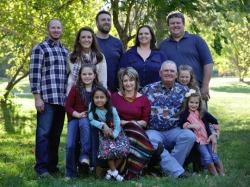Meet Brett Morris, New Beef Board Chairman
February 6, 2017 | 4 min to read

Dairy producer, cow-calf and stocker operator Brett Morris from Ninnekah, Okla., was elected by fellow Cattlemen’s Beef Board (CBB) members to serve as CBB chairman in 2017. The vote came today during the 2017 Cattle Industry Annual Convention in Nashville, Tenn.
Get to know Brett in the following interview:
Tell us about yourself and your history in the beef industry.
I'm a third generation dairy farmer. Although we recently sold the milking herd, I’m still involved in raising replacement registered Holstein heifers and I also retain ownership in several registered national show-quality Holstein cows that are being housed at Oklahoma State University for teaching purposes.
My father and I are partners in our farming operation, which consists of 1,000 acres of alfalfa, wheat and grassland. We are currently rebuilding our beef herd of commercial Black Angus cows, raising the steers to feeder weight and keeping the heifers for replacement and breeding them artificially. Being a diversified operation, we also own and operate Washita Fertilizer Company.
I was originally nominated to the Beef Board by the Dairy Farmers of America and remain active in both industry and community activities. I have served as chairman of the Oklahoma Dairy Commission, vice chairman of the Oklahoma Johne's Advisory Committee, as a district voting delegate to DFA, and as chairman and vice chairman of the Oklahoma Beef Council, which I have served on since 2005. I have also served on the checkoff's Joint Retail Committee as a representative for the Federation of State Beef Councils, was president of the Oklahoma Holstein Association, and was active in the National Council of
Farmer Cooperatives.
In addition to DFA, I am a member of the Oklahoma Farmers and Ranchers Mutual Insurance Company (a National Farmers Union affiliate), the Oklahoma Cattlemen's Association, Holstein Association of America, and Oklahoma Holstein Association.
In my community, I have enjoyed being a judge at the Arizona State Fair, the Sooner State Dairy Show, various state and local FFA events, as well as being a member of the Ninnekah City Council. My family and I attend Woodland Hills Baptist Church.
What do you believe is the biggest strength you bring to the table as chair?
I believe the biggest strength I bring to the table as chairman is my ability to effectively listen to the concerns of others and make objective decisions with the best outcome that benefits everyone. I also embrace the team approach to accomplishing tasks and believe that when you are surrounded by strong team leaders—in this case the CBB staff and members—great things develop that could not be accomplished by a single person.
Tell us about your family.
I am extremely proud of my family. My wife Jackie and I have three daughters and one son ranging in ages from 9 to 35. Our oldest daughter, an elementary school teacher, lives nearby on our farm with her family (including two of our granddaughters). Our son is a chef at a high-end steak and chophouse in Dallas. Our second daughter, a freelance photographer, lives just 30 miles away with her family (including our youngest granddaughter). Our youngest daughter lives at home and enjoys singing, piano and gymnastics. My parents are Earl Jr. and Barbara Morris, with whom I have ranched and farmed with all my life.
What do you hope to accomplish during your year as chair?
I hope to accomplish a better understanding of how the checkoff is used through investor education and communication. Since I have had the opportunity to speak with investors throughout the nation over the past few years, I have learned that there are numerous misconceptions about how their checkoff dollars are spent. I have discovered that when you are able to have an open, transparent and educational conversation with producers to dispel those myths, they become more confident that their investment is being spent wisely.
What do you see as one of the biggest challenges facing the checkoff and the industry?
I can see more than one challenge. The most challenging issue would be the limited amount of assessments being collected to pay for all the programs. We have been faced with this dilemma for several years, mainly due to the nation’s declining herd. The industry is now in an upward trend of building the herd, which brings us a larger beef supply.
With 95 percent of the world’s population and 80 percent of the global buying power outside of the United States, the second issue is moving our beef internationally. We can consume only so much beef domestically, which is why export growth is so important to balance the scales of supply and demand.
What would you like every investor to know about their Beef Checkoff Program?
I would like the investor to know that every board member volunteers his or her time and works extremely hard to ensure that checkoff investors receive the biggest bang for their buck. There are countless days and hours put into the work done by the board members on committees throughout the year, as well as back home in their individual communities. I understand and appreciate the time commitment invested by the board members and hope that the investors do as well.
For more information about your beef checkoff investment, visit MyBeefCheckoff.com.
UNDERSTANDING THE BEEF CHECKOFF PROGRAM
The Beef Checkoff Program was established as part of the 1985 Farm Bill. The checkoff assesses $1 per head on the sale of live domestic and imported cattle, in addition to a comparable assessment on imported beef and beef products. States may retain up to 50 cents on the dollar and forward the other 50 cents per head to the Cattlemen's Beef Promotion and Research Board, which administers the national checkoff program, subject to USDA approval.
Source: The Beef Checkoff Program
